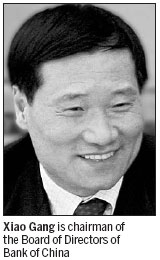Op-Ed Contributors
Liberalize interest rates further
By Xiao Gang (China Daily)
Updated: 2011-01-07 07:40
 |
Large Medium Small |

On Christmas day, China's central bank raised interest rates for the second time in 2010 to check rising consumer prices and the heated real estate market. It would not be surprising to see the central bank lift the rates again in the near future.
The move has left me wondering whether allowing interest rates to play their due role in the economy through liberalization, as opposed to raising them artificially time and again, would be a better way of curbing inflation.
While there has been remarkable progress in the interest rate reform since the mid-1990s, China still has restrictive controls over deposit rates and sets a 10 percent floor on benchmark lending rates. It is not hard to see the challenges our economy now faces because of these controls. The rise of the consumer price index by 5.1 percent in November has left negative real rates for deposits, that is, deposit rates are lower than inflation. This indicates that households' purchasing power is being eroded by the rise in consumer prices.
In the intensifying competition to attract deposits with relatively low rates, some domestic commercial banks have even engaged in irregularities such as handing out gifts, or even cash and gold, as rewards to their customers. This kind of behavior shows that the repressed interest rates for deposits do not reflect the real level of market rates. Thus it is reasonable to believe that the interest rates on deposits will automatically rise once they are allowed to fluctuate within a certain range.
Furthermore, liberalization of interest rates is good for the health of our banking industry. It will force banks to become more creative by intensifying competition, narrowing the net interest margin and shrinking the room for profits. That would immediately create incentives for banks to give more loans to small- and medium-sized enterprises, a sector in which banks enjoy higher lending rates, to maintain the financial institutions' profitability. Also, it could help enable the banking industry to change its business model from one that overly relies on income from interests to one that focuses on providing comprehensive and diversified services to customers.
China's banking system will become stronger only when the protection provided by the government's interest rates controls is lifted. If that happens, the pricing capability of a bank will be at the center of its competitiveness. Now, commercial banks simply decide their lending rates according to the regulated benchmark, coupled with clients' ratings and guarantees, but they do not fully incorporate the risks into their pricing.
Once interest rates are liberalized, banks have to measure the risk compensation level by calculating the client's probability of default with their own models before deciding on the lending rates. Things then will be different for every bank and the ones that are really good at risk pricing will stand out and thrive.



